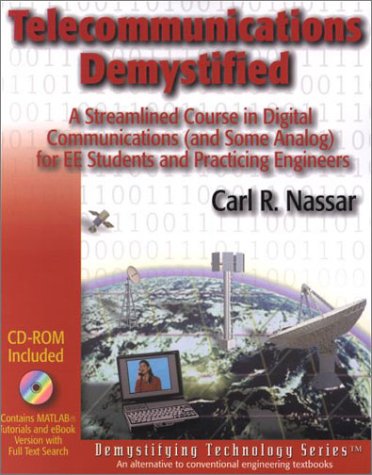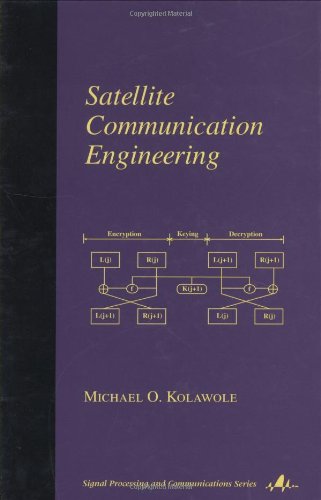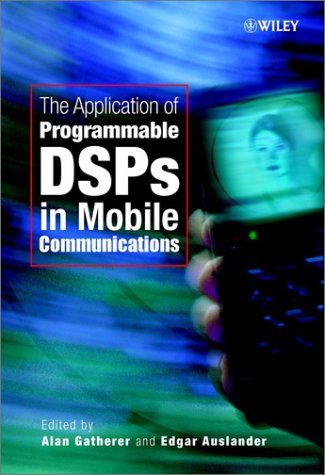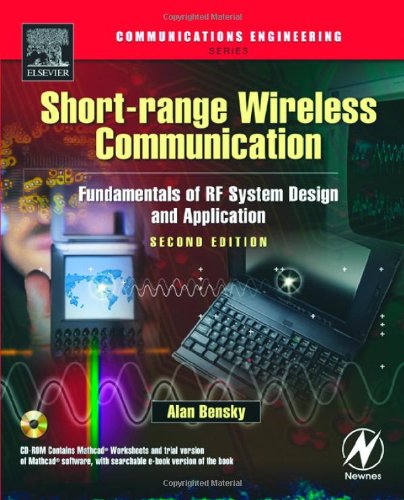Carl R. Nassar9781878707550, 1-878707-55-8
Table of contents :
Communication Systems……Page 20
An Example of a Communication System……Page 21
Definition……Page 22
Four Examples and an Erratic History Lesson……Page 23
Some Introductory Definitions……Page 25
And Digital Became the Favorite……Page 27
Making It Digital……Page 28
Congrats and Conclusion……Page 29
Problems……Page 30
Connecting People with Telephones……Page 32
Connecting More People, Farther Apart……Page 33
An Alternative to AM—DSB-SC……Page 0
First There Was FDM……Page 35
Along Came TDM……Page 37
Local Calls……Page 38
Connecting the Call……Page 39
The Signals Sent from Switching Center to Switching Center……Page 40
Class 5 to Class 4……Page 41
Transmission Lines (Wires)……Page 43
Terrestrial Microwave……Page 45
Satellite Connections……Page 47
Fiber-optic Links……Page 48
Data Communication Networks……Page 50
Mobile Communications……Page 52
Local Area Networks (LANs)……Page 54
Problems……Page 57
The Distribution Function: One Way to Describe x……Page 58
The Density Function: A Second Way to Describe x……Page 59
The Mean and the Variance……Page 60
Example 3.1……Page 62
Multiple Random Variables……Page 63
A Definition……Page 64
Expressing Some of Yourself, or a Partial Description……Page 66
Example 3.2……Page 67
A Few Signals……Page 69
Another Way to Represent a Signal: The Fourier Transform……Page 70
Example 3.3……Page 71
Bandwidth……Page 72
A Linear Time Invariant (LTI) System……Page 74
Some Special Linear Time Invariant (LTI) Systems……Page 75
Onward……Page 77
Problems……Page 78
The Sampling……Page 80
The Information in the Samples……Page 81
Getting Back All the Information from the Samples……Page 83
Some Commonly Used Words……Page 84
Example 4.1……Page 85
The Information in the Samples……Page 86
Example 4.2……Page 87
Natural Sampling……Page 88
The Information in the Samples……Page 89
Meet the Quantizer……Page 90
Who wants it?……Page 92
Quantizer Terms……Page 93
Types of Quantizers……Page 94
Example 4.4……Page 95
Measures of Performance……Page 96
Creating the Good Quantizer……Page 100
Example 4.5……Page 105
The Idea……Page 107
Introducing the PCM……Page 111
PCM Talk……Page 112
Source Decoder: PCM Decoder……Page 114
Predictive Coding……Page 115
Why?……Page 116
The Predicted Value and the Predictive Decoder……Page 117
How the DM creates an……Page 118
The Sampler and the Quantizer in the DM……Page 119
The Signals in the DM……Page 120
Example 4.6……Page 123
Overload and Granular Noise……Page 124
The Predicted Value……Page 126
The Block Diagram……Page 128
Congrats and Conclusion……Page 129
Problems……Page 130
An Introduction……Page 134
Baseband Modulators……Page 135
NRZ Modulators……Page 136
RZ Modulators……Page 137
Phase-encoded Modulators……Page 139
Which Modulator to Use?……Page 141
Bandpass Modulators……Page 143
ASK……Page 144
PSK……Page 146
FSK……Page 148
QAM……Page 149
Choosing a Modulation Method……Page 150
Just-in- Time Math, or How to Make a Modulator Signal Look Funny……Page 152
The Idea……Page 153
Example 5.3……Page 155
Representing Modulated Signals……Page 157
BPSK……Page 158
PSK……Page 159
ASK……Page 162
QAM……Page 164
What Demodulators Do……Page 165
The Channel and Its Noise……Page 166
An orthonormal basis for r(t)……Page 167
Representing r(t) as a vector using the orthonormal basis……Page 168
Building the Receiver Front End……Page 170
What It Does……Page 171
How It Works……Page 172
The Correlator Receiver……Page 175
Example 5.5……Page 176
A Performance Measure……Page 180
The BPSK Demodulator: A Summary……Page 181
Evaluating the P(……Page 182
What We Just Did……Page 185
Problems……Page 186
6 Channel Coding and Decoding:……Page 190
The Single Parity Check Bit Coder……Page 191
Example 6.1……Page 193
Channel Coders for Rectangular Codes……Page 194
Example 6.2……Page 195
Introduction……Page 196
Example 6.3……Page 197
Understanding Why……Page 198
Example 6.4……Page 200
The Decoding……Page 201
Example 6.5……Page 203
Example 6.6……Page 205
Performances of Single Parity Check Bit Coders/Decoders……Page 207
The Performance of Linear Block Codes……Page 208
Example 6.7……Page 209
Benefits and Costs of Block Coders……Page 211
Conclusion……Page 212
Problems……Page 213
Our Example……Page 216
Polynomial Representation……Page 219
The Trellis Diagram……Page 220
Example 7.1……Page 221
Channel Decoding……Page 222
Using a Trellis Diagram……Page 223
The Viterbi Algorithm……Page 225
Example 7.3……Page 231
Performance of the Convolutional Coder……Page 232
Catastrophic Codes……Page 233
Building Your Own……Page 235
Problems……Page 236
8 Trellis-Coded Modulation (TCM)……Page 240
The Idea……Page 241
Improving on the Idea……Page 244
Example 8.1……Page 248
The Receiver End of Things……Page 249
The Input……Page 250
The TCM Decoder Front End……Page 252
The Rest of the TCM Decoder……Page 253
Example 8.2……Page 255
Searching for the Best Path……Page 256
Problems……Page 261
Modulators and Pulse Shaping……Page 264
Example 9.1……Page 267
The Channel That Thought It Was a Filter……Page 268
Example 9.2……Page 269
The Proposed Receiver……Page 270
Making the Receiver a Good One……Page 273
The Proposed Receiver: Problems and Usefulness……Page 275
Example 9.3……Page 276
Optimal Receiver Front End……Page 277
The Input……Page 281
A Problem with the Input, and a Solution……Page 283
The Final Part of the Optimal Receiver……Page 284
Example 9.4……Page 289
Linear Equalizers……Page 290
Zero Forcing Linear Equalizer……Page 291
Example 9.5……Page 292
Other Equalizers: the FSE and the DFE……Page 293
Conclusion……Page 294
Problems……Page 295
Introduction……Page 298
Our Goal……Page 299
Estimating a Given r, the First Way……Page 300
Estimating a Given r, the Second Way……Page 301
Example 10.1……Page 302
Our Example and Its Theoretically Computed Estimate……Page 304
The Practical Estimator: the PLL……Page 309
Updates to the Practical Estimator in MPSK……Page 311
Conclusion……Page 314
Problems……Page 315
What It Is……Page 318
The Underlying Ideas……Page 319
Example 11.1……Page 321
TDMA……Page 322
FDMA……Page 324
Introduction……Page 325
DS-CDMA……Page 329
FH-CDMA……Page 331
MC-CDMA……Page 332
CIMA……Page 334
Conclusion……Page 337
Problems……Page 338
12 Analog Communications……Page 340
Amplitude Modulation (AM)……Page 341
Example 12.1……Page 344
Example 12.2……Page 352
Frequency Modulation (FM)……Page 353
The Modulator in FM……Page 354
Example 12.3……Page 357
The Superheterodyne Receiver……Page 358
Summary……Page 360
Problems……Page 361
Annotated References and Bibliography……Page 364
Index……Page 368







Reviews
There are no reviews yet.